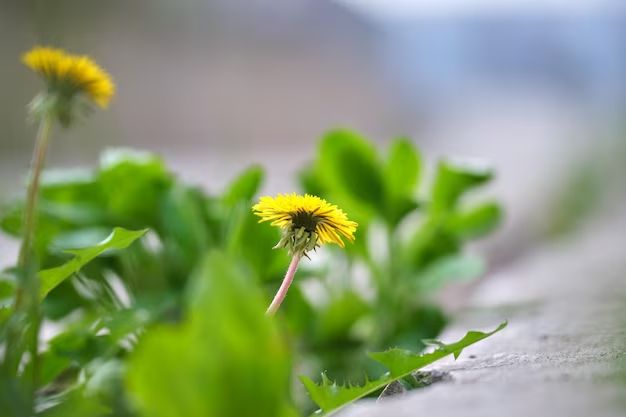The yellow flower weed commonly seen along roadsides is likely one of a few common weedy species. Some possibilities for the identity of this yellow flower weed include yellow sweet clover, wild mustard, goldenrod, or tickseed sunflower. Determining the exact species can require getting a closer look at details of the flower head, leaves, stem, and growing habit. Knowing your location can also help narrow down the likely suspects. Below we will explore how to identify the yellow flower weed by roadside through a process of elimination focusing on the most widespread yellow flowering weeds.
Page Contents
Distinguishing Traits of Common Yellow Flowering Weeds
Here is a quick overview of some of the defining features of the top candidates for the identity of the yellow flower roadside weed:
Yellow Sweet Clover
– Grows upright 2-7 feet tall
– Compound leaves with 3 leaflets
– Yellow flowers clustered in elongated heads about 1 inch long
– Blooms May-September
– Widespread across North America
Wild Mustard
– Grows 1-4 feet tall
– Irregularly lobed and toothed leaves
– Small yellow 4-petaled flowers clustered at ends of branches
– Blooms April-June
– Found nationwide
Common Goldenrod
– Grows 1-5 feet tall
– Lance-shaped leaves with toothed edges
– Many small yellow flowers in plume-like clusters at top of stem
– Blooms July-October
– Native across North America
Tickseed Sunflower
– Grows 1-3 feet tall
– Thin alternating leaves
– Solitary daisy-like yellow flowers at ends of stems
– Blooms June-October
– Native to eastern and central North America
Distinguishing Features in Detail
To positively identify the yellow flower weed, you’ll need to observe some key differences among these options. Here is a more in-depth look at features to compare:
Leaf Shape and Arrangement
– Yellow sweet clover has compound leaves divided into 3 leaflets. The leaflets are oblong with smooth edges. Leaves arranged alternately along the stem.
– Wild mustard has deeply lobed and toothed leaves of various shapes like ovals, spoon-shapes, or triangles. Leaves are alternate.
– Goldenrod has simple lance-shaped leaves with toothed edges. Leaves are alternate and get smaller toward top of stem.
– Tickseed sunflower has slender elongated leaves that are alternately arranged. Leaves are entire without lobes or teeth.
Flower Appearance
– Yellow sweet clover has flowers densely packed into elongated conical heads about 1 inch long. Each tiny 5-petaled blossom is about 1/8 inch wide.
– Wild mustard has 4-petaled flowers about 1/4 inch wide in loose clusters at ends of branches. Some varieties may have darker veining.
– Goldenrod flowers are tiny about 1/8 inch across and densely packed into plume-like pyramidal clusters. The petals are not easily visible.
– Tickseed sunflower has showy solitary flowers like small daisies at the ends of stems. The bright yellow rays are about 1 inch long surrounding the darker disk.
Growth Habit
– Yellow sweet clover grows upright from a taproot, reaching 2-7 feet tall. Stems are erect and may be branched near the top.
– Wild mustard grows quickly as a basal rosette then sends up multiple ascending flower stalks 1-4 feet tall. Stems are light green and covered in bristly hairs.
– Goldenrods grow upright on unbranched reddish stems, typically reaching 1-5 feet tall. They emerge in clumps from shallow rhizomatous roots.
– Tickseed sunflowers grow as solitary stems from 1-3 feet tall. Stems are thin, branched, and mostly hairless arising from fibrous roots.
When and Where Do These Weeds Grow?
Knowing the bloom period and native range of these yellow weed flowers can also lend clues to their identity:
| Species | Bloom Time | Native Range |
|---|---|---|
| Yellow Sweet Clover | May-September | Throughout North America |
| Wild Mustard | April-June | Throughout North America |
| Common Goldenrod | July-October | Throughout North America |
| Tickseed Sunflower | June-October | Eastern and Central North America |
As you can see, yellow sweet clover and wild mustard have the earliest bloom periods, while goldenrod and tickseed sunflower peak later in the summer through fall. Yellow sweet clover and wild mustard are also the most widespread across North America. So time of year and location may indicate which are the most likely suspects for your yellow roadside flower.
Weed Status and Control
Many of these yellow flowering weeds are considered invasive or noxious. Here is some background on their weed status and how to control them:
Yellow Sweet Clover
Though sometimes planted for livestock forage and soil improvement, yellow sweet clover spreads aggressively and is classified as a noxious weed in several states. Control methods include mowing, applying selective herbicides, and preventing seed production.
Wild Mustard
Wild mustard is an aggressive invasive weed across much of North America. Manual removal can be effective for small infestations. Applying selective herbicides like 2,4-D or glyphosate provides chemical control. Preventing seed spread also limits new growth.
Common Goldenrod
Though native, goldenrod can spread rapidly and become weedy in ideal growing conditions. Control includes manual removal, mowing, or spot-treating with herbicides before flowering. Promoting competition from desired vegetation also slows spread.
Tickseed Sunflower
Tickseed sunflower spreads aggressively by seed and rhizomes. Manual digging can control small patches. Repeated mowing through the season helps prevent flowering and seed production. Applying selective herbicides to foliage also provides good control.
Conclusion
Identifying the yellow flower weed growing along roadsides requires careful observation of details. Compare the leaf shape and arrangement, flower clusters, growth habit, bloom time, and native range. Yellow sweet clover, wild mustard, goldenrod, and tickseed sunflower are top candidates. Many spread readily, so control methods like manual removal, mowing, herbicide application, and preventing seed spread may be warranted to check their invasion as weeds. Properly identifying the species is the important first step before undertaking any weed control measures.
